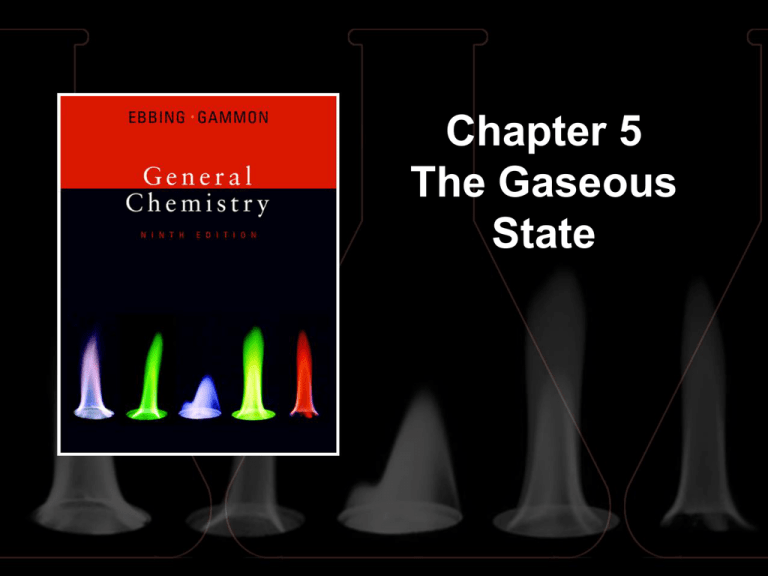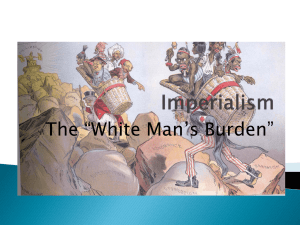
Chapter 5
The Gaseous
State
Contents and Concepts
Gas Laws
We will investigate the quantitative relationships
that describe the behavior of gases.
1. Gas Pressure and Its Measurement
2. Empirical Gas Laws
3. The Ideal Gas Law
4. Stoichiometry Problems Involving Gas Volumes
5. Gas Mixtures; Law of Partial Pressures
Copyright © Houghton Mifflin Company. All rights reserved.
5|2
Kinetic-Molecular Theory
This section will develop a model of gases as
molecules in constant random motion.
6. Kinetic Theory of Gases
7. Molecular Speeds; Diffusion and Effusion
8. Real Gases
Copyright © Houghton Mifflin Company. All rights reserved.
5|3
Gases are compressible.
Gas volume depends on temperature and
pressure.
Pressure, volume, temperature, and amount
of a gas are related by the ideal gas law:
PV = nRT
Copyright © Houghton Mifflin Company. All rights reserved.
5|4
Pressure, P
The force exerted per unit area
It can be given by two equations:
F
P
A
P dgh
The SI unit for pressure is the pascal, Pa.
kg m
s 2 kg
m2
m s2
Pa (pascal)
Copyright © Houghton Mifflin Company. All rights reserved.
kg m
kg
2 m
3
m
s
m s2
Pa (pascal)
5|5
Pressure exerted by
a column of fluid
Volume: V hA
Mass: m Vd
(h=height, A=area)
(d =density)
Force: F ma Vdg hAdg
(g =acceleration due to gravity)
Pressure: P F / A (hAdg ) / A hdg
Copyright © Houghton Mifflin Company. All rights reserved.
5|6
Copyright © Houghton Mifflin Company. All rights reserved.
5|7
A barometer is a
device for measuring
the pressure of the
atmosphere.
A manometer is a
device for measuring
the pressure of a
gas or liquid in a
vessel.
Copyright © Houghton Mifflin Company. All rights reserved.
5|8
The water column would be
higher because its density is less
by a factor equal to the density
of mercury to the density of
water.
P gdh
gdHg hHg gdH2O hH2O
hH2O hHg
d Hg
d H2O
Copyright © Houghton Mifflin Company. All rights reserved.
5|9
Empirical Gas Laws
All gases behave quite simply with respect to
temperature, pressure, volume, and molar amount.
By holding two of these physical properties
constant, it becomes possible to show a simple
relationship between the other two properties.
The studies leading to the empirical gas laws
occurred from the mid-17th century to the mid-19th
century.
Copyright © Houghton Mifflin Company. All rights reserved.
5 | 10
Boyle’s Law
The volume of a sample of gas at constant
temperature varies inversely with the applied
pressure.
1
The mathematical relationship: V
P
In equation form:
PV constant
PiVi PfVf
Copyright © Houghton Mifflin Company. All rights reserved.
5 | 11
Figure A shows the
plot of V versus P for
1.000 g O2 at 0°C.
This plot is nonlinear.
Copyright © Houghton Mifflin Company. All rights reserved.
Figure B shows the
plot of (1/V) versus P
for 1.000 g O2 at 0°C.
This plot is linear,
illustrating the inverse
relationship.
5 | 12
At one atmosphere
the volume of the
gas is 100 mL. When
pressure is doubled,
the volume is halved
to 50 mL. When
pressure is tripled,
the volume
decreases to onethird, 33 mL.
Copyright © Houghton Mifflin Company. All rights reserved.
5 | 13
When a 1.00-g sample of O2
gas at 0C is placed in a
containerat a pressure of 0.50
atm, it occupies a volume of
1.40 L.
When the pressure on the O2 is
doubled to 1.0 atm, the volume
is reduced to 0.70 L, half the
original volume.
Copyright © Houghton Mifflin Company. All rights reserved.
5 | 14
?
A volume of oxygen gas occupies 38.7
mL at 751 mmHg and 21°C. What is
the volume if the pressure changes to
359 mmHg while the temperature
remains constant?
Vi = 38.7 mL
Pi = 751 mmHg
Ti = 21°C
PV
i i = PV
f f
Copyright © Houghton Mifflin Company. All rights reserved.
Vf = ?
Pf = 359 mmHg
Tf = 21°C
PV
Vf i i
Pf
5 | 15
Vi = 38.7 mL
Pi = 751 mmHg
Ti = 21°C
Vf = ?
Pf = 359 mmHg
Tf = 21°C
PiVi
Vf
Pf
(38.7 mL)(751mmHg)
Vf
(359 mmHg)
= 81.0 mL
(3 significant figures)
Copyright © Houghton Mifflin Company. All rights reserved.
5 | 16
A graph of V versus T is linear. Note that all lines cross
zero volume at the same temperature, -273.15°C.
Copyright © Houghton Mifflin Company. All rights reserved.
5 | 17
The temperature -273.15°C is called absolute
zero. It is the temperature at which the volume of a
gas is hypothetically zero.
This is the basis of the absolute temperature scale,
the Kelvin scale (K).
When working with gas laws (and almost anything
related to thermochemistry), the first thing you
should do is convert the temperature to Kelvin
Copyright © Houghton Mifflin Company. All rights reserved.
5 | 18
Charles’s Law
The volume of a sample of gas at constant
pressure is directly proportional to the absolute
temperature (K).
The mathematical relationship:
In equation form:
V T
V
constant
T
Vi Vf
Ti Tf
Copyright © Houghton Mifflin Company. All rights reserved.
5 | 19
A balloon was immersed
in liquid nitrogen (black
container) and is shown
immediately after being
removed. It shrank
because air inside
contracts in volume.
Copyright © Houghton Mifflin Company. All rights reserved.
As the air inside warms,
the balloon expands to
its orginial size.
5 | 20
A 1.0-g sample of O2 at a
temperature of 100 K and a
pressure of 1.0 atm occupies a
volume of 0.26 L.
When the absolute temperature
of the sample is raised to 200 K,
the volume of the O2 is doubled
to 0.52 L.
Copyright © Houghton Mifflin Company. All rights reserved.
5 | 21
?
You prepared carbon dioxide by adding
HCl(aq) to marble chips, CaCO3.
According to your calculations, you
should obtain 79.4 mL of CO2 at 0°C
and 760 mmHg. How many milliliters of
gas would you obtain at 27°C?
Vi = 79.4 mL
Pi = 760 mmHg
Ti = 0°C = 273 K
Vi Vf
=
Ti Tf
Copyright © Houghton Mifflin Company. All rights reserved.
Vf = ?
Pf = 760 mmHg
Tf = 27°C = 300. K
TfVi
Vf
Ti
5 | 22
Vi = 79.4 mL
Pi = 760 mmHg
Ti = 0°C = 273 K
Vf = ?
Pf = 760 mmHg
Tf = 27°C = 300. K
TfVi
Vf
Ti
(300. K)(79.4 mL)
Vf
(273 K)
= 87.3 mL
(3 significant figures)
Copyright © Houghton Mifflin Company. All rights reserved.
5 | 23
Combined Gas Law
The volume of a sample of gas at constant
pressure is inversely proportional to the pressure
and directly proportional to the absolute
temperature.
T
The mathematical relationship: V
P
PV
In equation form:
constant
T
PiVi PfVf
Ti
Tf
Copyright © Houghton Mifflin Company. All rights reserved.
5 | 24
?
Divers working from a North Sea
drilling platform experience pressure of
5.0 × 101 atm at a depth of 5.0 × 102 m.
If a balloon is inflated to a volume of
5.0 L (the volume of the lung) at that
depth at a water temperature of 4°C,
what would the volume of the balloon
be on the surface (1.0 atm pressure) at
a temperature of 11°C?
Vi = 5.0 L
Pi = 5.0 × 101 atm
Ti = 4°C = 277 K
Copyright © Houghton Mifflin Company. All rights reserved.
Vf = ?
Pf = 1.0 atm
Tf = 11°C = 284 K
5 | 25
Vi = 5.0 L
Pi = 5.0 × 101 atm
Ti = 4°C = 277 K
Vf = ?
Pf = 1.0 atm
Tf = 11°C = 284. K
Tf PiVi
Vf
Ti Pf
(284 K)(5.0 x 101 atm)(5.0L)
Vf
(277 K)(1.0 atm)
= 2.6 x 102 L
(2 significant figures)
Copyright © Houghton Mifflin Company. All rights reserved.
5 | 26
Avogadro’s Law
Equal volumes of any two gases at the same
temperature and pressure contain the same
number of molecules.
Copyright © Houghton Mifflin Company. All rights reserved.
5 | 27
Standard Temperature and Pressure (STP)
The reference condition for gases, chosen by
convention to be exactly 0°C and 1 atm pressure.
The molar volume, Vm, of a gas at STP is 22.4
L/mol.
The volume of the
yellow box is 22.4 L. To
its left is a basketball.
Copyright © Houghton Mifflin Company. All rights reserved.
5 | 28
Ideal Gas Law
P1V1=P2V2 or
PV=constant (at constant n and T)
V1/T1=V2/T2 or
V/T=constant (at constant n and P)
Avogadro’s Law V1/V2=n1/n2 or
V/n=constant (ant constant P and T)
PV/nT=constant=R
PV=nRT
Copyright © Houghton Mifflin Company. All rights reserved.
5 | 29
Ideal Gas Law
The ideal gas law is
given by the equation
PV=nRT
The molar gas
constant, R, is the
constant of
proportionality that
relates the molar
volume of a gas to T/P.
Copyright © Houghton Mifflin Company. All rights reserved.
5 | 30
?
A 50.0-L cylinder of nitrogen, N2, has a
pressure of 17.1 atm at 23°C. What is the mass
of nitrogen in the cylinder?
V = 50.0 L
P = 17.1 atm
T = 23°C = 296 K
PV
n
RT
(17.1atm )(50.0L)
n
L atm
0.08206
(296 K)
m ol K
28.01g
mass 35.20mol
mol
Copyright © Houghton Mifflin Company. All rights reserved.
mass = 986 g
(3 significant figures)
5 | 31
Gas Density and Molar Mass
Using the ideal gas law, it is possible to calculate
the moles in 1 L at a given temperature and
pressure. The number of moles can then be
converted to density (grams per liter).
To find molar mass, find the moles of gas, and
then find the ratio of mass to moles.
n
P
PV = nRT or
V RT
m nMm PMm
d= =
V
V
RT
Copyright © Houghton Mifflin Company. All rights reserved.
dRT
or Mm
P
5 | 32
?
What is the density of methane gas
(natural gas), CH4, at 125°C and 3.50
atm?
Mm = 16.04 g/mol
P = 3.50 atm
T = 125°C = 398 K
Mm P
d
RT
g
(16.04
)(3.50 atm)
mol
d
L atm
0.08206
(398 K)
mol K
Copyright © Houghton Mifflin Company. All rights reserved.
g
d 1.72
L
(3 significant figures)
5 | 33
?
A 500.0-mL flask containing a sample
of octane (a component of gasoline) is
placed in a boiling water bath in
Denver, where the atmospheric
pressure is 634 mmHg and water boils
at 95.0°C. The mass of the vapor
required to fill the flask is 1.57 g. What
is the molar mass of octane? (Note:
The empirical formula of octane is
C4H9.) What is the molecular formula of
octane?
Copyright © Houghton Mifflin Company. All rights reserved.
5 | 34
d = 1.57 g/0.5000 L
= 3.140 g/L
P = 634 mmHg
= 0.8342 atm
dRT
Mm
P
T = 95.0°C = 368.2 K
Mm
g
L atm
3.140 0.08206
368.2K
L
mol K
(0.8342atm)
g
M m 114
mol
(3 significant figures)
Copyright © Houghton Mifflin Company. All rights reserved.
5 | 35
Molar mass = 114 g/mol
Empirical formula: C4H9
Empirical formula molar mass = 57 g/mol
g
114
mol 2
n
g
57
mol
Molecular formula: C8H18
Copyright © Houghton Mifflin Company. All rights reserved.
5 | 36
Stoichiometry and Gas Volumes
Use the ideal gas law to find moles from a given
volume, pressure, and temperature, and vice
versa.
Copyright © Houghton Mifflin Company. All rights reserved.
5 | 37
?
When a 2.0-L bottle of concentrated
HCl was spilled, 1.2 kg of CaCO3 was
required to neutralize the spill. What
volume of CO2 was released by the
neutralization at 735 mmHg and 20.°C?
Copyright © Houghton Mifflin Company. All rights reserved.
5 | 38
First, write the balanced chemical equation:
CaCO3(s) + 2HCl(aq)
CaCl2(aq) + H2O(l) + CO2(g)
Second, calculate the moles of CO2 produced:
Molar mass of CaCO3 = 100.09 g/mol
1 mol CaCO3
1 mol CO 2
1.2 x 10 g CaCO3
100.09g CaCO3 1 mol CaCO3
3
Moles of CO2 produced = 11.99 mol
Copyright © Houghton Mifflin Company. All rights reserved.
5 | 39
n = 12.0 mol
P = 735 mmHg
= 0.967 atm
T = 20°C = 293 K
nRT
V
P
L atm
12.0 mol 0.08206
(293 K)
mol K
V
(0.967 atm)
= 3.0 × 102 L
(2 significant figures)
Copyright © Houghton Mifflin Company. All rights reserved.
5 | 40
Gas Mixtures
Dalton found that in a mixture of unreactive gases
each gas acts as if it were the only the only gas in
the mixture as far as pressure is concerned.
Copyright © Houghton Mifflin Company. All rights reserved.
5 | 41
Originally (left), flask A contains He at 152 mmHg
and flask B contains O2 at 608 mmHg. Flask A is
then filled with oil forcing the He into flask B (right).
The new pressure in flask B is 760 mmHg
Copyright © Houghton Mifflin Company. All rights reserved.
5 | 42
Partial Pressure
The pressure exerted by a particular gas in a
mixture
Dalton’s Law of Partial Pressures
The sum of the partial pressures of all the different
gases in a mixture is equal to the total pressure of
the mixture:
P = PA + PB + PC + . . .
Copyright © Houghton Mifflin Company. All rights reserved.
5 | 43
?
A 100.0-mL sample of air exhaled from
the lungs is analyzed and found to
contain 0.0830 g N2, 0.0194 g O2,
0.00640 g CO2, and 0.00441 g water
vapor at 35°C. What is the partial
pressure of each component and the
total pressure of the sample?
Copyright © Houghton Mifflin Company. All rights reserved.
5 | 44
1 mol N2
0.0830g N2
28.01g N2
L atm
0.08206
308 K
mol K
0.749 atm
PN2
100.0mL 13L
10 mL
1 mol O 2
L atm
0.0194g O 2
0.08206
308 K
32.00 g O 2
mol K
0.153 atm
PO2
100.0mL 13L
10 mL
1 mol CO 2
L atm
0.00640g CO 2
0.08206
308 K
44.01g CO 2
mol K
0.0368atm
PCO 2
100.0mL 13L
10 mL
1 mol H2 O
L atm
0.00441g H2 O
0.08206
308 K
18.01
g
H
O
mol
K
2
0.0619atm
PH2O
1L
100.0mL 3
10 mL
Copyright © Houghton Mifflin Company. All rights reserved.
5 | 45
PN2 0.749atm
PO2 0.153atm
PCO 2 0.0368atm
PH2O 0.0619atm
P PN2 PO2 PCO 2 PH2O
P = 1.00 atm
Copyright © Houghton Mifflin Company. All rights reserved.
5 | 46
?
The partial pressure of air in the alveoli
(the air sacs in the lungs) is as follows:
nitrogen, 570.0 mmHg; oxygen, 103.0
mmHg; carbon dioxide, 40.0 mmHg;
and water vapor, 47.0 mmHg. What is
the mole fraction of each component of
the alveolar air?
PN2 570.0mmHg
PO2 103.0Hg
PCO 2 40.0 mmHg
PH2O 47.0 mmHg
Copyright © Houghton Mifflin Company. All rights reserved.
5 | 47
P PN2 PO2 PCO 2 PH2O
570.0 mmHg
103.0 mmHg
40.0 mmHg
47.0 mmHg
P = 760.0 mmHg
Copyright © Houghton Mifflin Company. All rights reserved.
5 | 48
Mole fraction of N2
570.0 mmHg
760.0 mmHg
Mole fraction of O2
103.0 mmHg
760.0 mmHg
Mole fraction of CO2
40.0 mmHg
760.0 mmHg
Mole fraction of H2O
47.0 mmHg
760.0 mmHg
Mole fraction N2 = 0.7500
Mole fraction O2 = 0.1355
Mole fraction CO2 = 0.0526
Mole fraction O2 = 0.0618
Copyright © Houghton Mifflin Company. All rights reserved.
5 | 49
Collecting Gas Over Water
Gases are often collected over water. The result is
a mixture of the gas and water vapor.
The total pressure is equal to the sum of the gas
pressure and the vapor pressure of water.
The partial pressure of water depends only on
temperature and is known (Table 5.6).
The pressure of the gas can then be found using
Dalton’s law of partial pressures
Copyright © Houghton Mifflin Company. All rights reserved.
5 | 50
The reaction of Zn(s) with HCl(aq) produces
hydrogen gas according to the following reaction:
Zn(s) + 2HCl(aq) ZnCl2(aq) + H2(g)
The next slide illustrates the apparatus used to
collect the hydrogen. The result is a mixture of
hydrogen and water vapor.
Copyright © Houghton Mifflin Company. All rights reserved.
5 | 51
Copyright © Houghton Mifflin Company. All rights reserved.
5 | 52
P 769 mmHg
At 19C, PH2O 16.5 mmHg
(See T able5.6)
P PH2 PH2O
PH2 P PH2O
PH2 769 mmHg 16.5 mmHg
PH2 752.5mmHg
PH2 753 mmHg
(no decimalplaces)
Copyright © Houghton Mifflin Company. All rights reserved.
5 | 53
?
You prepare nitrogen gas by heating
ammonium nitrite:
NH4NO2(s) N2(g) + 2H2O(l)
If you collected the nitrogen over water
at 23°C and 727 mmHg, how many
liters of gas would you obtain from 5.68
g NH4NO2?
P = 727 mmHg
Pvapor = 21.1 mmHg
Pgas = 706 mmHg
T = 23°C = 296 K
Copyright © Houghton Mifflin Company. All rights reserved.
Molar mass NH4NO2
= 64.05 g/mol
5 | 54
P = 727 mmHg
Pvapor = 21.1 mmHg
Pgas = 706 mmHg
T = 23°C = 296 K
Molar mass NH4NO2
= 64.04 g/mol
nRT
V
P
1 mol CaCo3
1 mol CO 2
5.68 g CaCO3
64.04 g CaCO3 1 mol CaCO3
= 0.8869 mol CO2 gas
Copyright © Houghton Mifflin Company. All rights reserved.
5 | 55
P = 727 mmHg
Pvapor = 21.1 mmHg
Pgas = 706 mmHg
T = 23°C = 296 K
n = 0.8869 mol
nRT
V
P
L atm
0.0887mol 0.08206
(296 K)
mol K
V
1 atm
706 mmHg
760 mmHg
= 2.32 L of CO2
(3 significant figures)
Copyright © Houghton Mifflin Company. All rights reserved.
5 | 56
Kinetic-Molecular Theory (Kinetic Theory)
A theory, developed by physicists, that is based on
the assumption that a gas consists of molecules in
constant random motion.
Kinetic energy is related to the mass and velocity:
1
EK mv 2
2
m = mass
v = velocity
Program demonstrating kinetic-molecular theory:
http://people.chem.byu.edu/rbshirts/research/boltzmann_3d
Copyright © Houghton Mifflin Company. All rights reserved.
5 | 57
Postulates of the Kinetic Theory
1. Gases are composed of molecules whose
sizes are negligible.
2. Molecules move randomly in straight lines in all
directions and at various speeds.
3. The forces of attraction or repulsion between
two molecules (intermolecular forces) in a gas
are very weak or negligible, except when the
molecules collide.
4. When molecules collide with each other, the
collisions are elastic.
5. The average kinetic energy of a molecule is
proportional to the absolute temperature.
Copyright © Houghton Mifflin Company. All rights reserved.
5 | 58
An elastic collision is one in which no kinetic
energy is lost. The collision on the left causes the
ball on the right to swing the same height as the
ball on the left had initially, with essentially no loss
of kinetic energy.
Copyright © Houghton Mifflin Company. All rights reserved.
5 | 59
Each of the gas laws can be derived from the
postulates.
For the ideal gas law:
P frequency of collision x average force
Copyright © Houghton Mifflin Company. All rights reserved.
5 | 60
The average force depends on the mass of the
molecules, m, and its average speed, u; it depends
on momentum, mu.
The frequency of collision is proportional to the
average speed, u, and the number of molecules,
N, and inversely proportional to the volume, V.
1
P u N mu
V
Copyright © Houghton Mifflin Company. All rights reserved.
5 | 61
Rearranging this relationship gives
PV Nmu2
The average kinetic energy of a molecule of
mass m and average speed u is 1/2mu2.
Thus PV is proportional to the average kinetic
energy of the molecule.
Copyright © Houghton Mifflin Company. All rights reserved.
5 | 62
However, the average kinetic energy is also
proportional to the absolute temperature and the
number of molecules, N, is proportional to moles of
molecules. We now have
PV nT
Inserting the proportionality constant, R, gives
PV nRT
Copyright © Houghton Mifflin Company. All rights reserved.
5 | 63
Molecular Speeds
According to kinetic theory, molecular speeds vary
over a wide range of values. The distribution
depends on temperature, so it increases as the
temperature increases.
Root-Mean Square (rms) Molecular Speed, u
A type of average molecular speed, equal to the
speed of a molecule that has the average
molecular kinetic energy
u
Copyright © Houghton Mifflin Company. All rights reserved.
3RT
Mm
5 | 64
When using the equation
R = 8.3145 J/(mol K)
T must be in kelvins
Mm must be in kg/mol
Copyright © Houghton Mifflin Company. All rights reserved.
5 | 65
?
What is the rms speed of carbon
dioxide molecules in a container at
23°C?
T = 23°C = 296 K
CO2 molar mass =
0.04401 kg/mol
Copyright © Houghton Mifflin Company. All rights reserved.
u rms
3RT
Mm
5 | 66
Recall
kg m 2
J
s2
u rms
kg m 2
2
296 K
3 8.3145 s
mol K
kg
0.04401
mol
urms
2
m
1.68x105 2
s
urms
Copyright © Houghton Mifflin Company. All rights reserved.
m
4.10 x10
s
2
5 | 67
?
Both hydrogen and helium have been
used as the buoyant gas in blimps. If a
small leak were to occur, which gas
would effuse more rapidly and by what
factor?
1
Rate H2
Rate He
2.016
1
4.002
2.016
4.002
Hydrogen will diffuse more quickly by a factor of 1.4.
Copyright © Houghton Mifflin Company. All rights reserved.
5 | 68
Copyright © Houghton Mifflin Company. All rights reserved.
5 | 69
a. He will reach the end first because it has a
smaller molar mass.
b. Open the valves at two different times, allowing
Ar more time by a factor equal to the square
root of the ratio of molar masses of Ar to He, or
approximately 3.16 times longer.
Copyright © Houghton Mifflin Company. All rights reserved.
5 | 70
Maxwell
predicted the
distributions
of molecular
speeds at
various
temperatures.
The graph
shows 0°C
and 500°C.
3/ 2
M
f (u) 4
2 RT
u 2 exp(Mu 2 / 2RT )
Copyright © Houghton Mifflin Company. All rights reserved.
5 | 71
Diffusion
The process whereby a gas spreads out through
another gas to occupy the space uniformly
Below NH3 diffuses through air. The indicator
paper tracks its progress.
Copyright © Houghton Mifflin Company. All rights reserved.
5 | 72
Effusion
The process by which a gas flows through a small
hole in a container. A pinprick in a balloon is one
example of effusion.
Copyright © Houghton Mifflin Company. All rights reserved.
5 | 73
Graham’s Law of Effusion
At constant temperature and pressure, the rate of
effusion of gas molecules through a particular hole
is inversely proportional to the square root of the
molecular mass of the gas.
rate of effusionof molecules
Copyright © Houghton Mifflin Company. All rights reserved.
1
Mm
5 | 74
Real Gases
At high pressure the relationship between pressure
and volume does not follow Boyle’s law. This is
illustrated on the graph below.
Copyright © Houghton Mifflin Company. All rights reserved.
5 | 75
At high pressure, some of the assumptions of the
kinetic theory no longer hold true:
1. At high pressure, the volume of the gas
molecule (Postulate 1) is not negligible.
2. At high pressure, the intermolecular forces
(Postulate 3) are not negligible.
Copyright © Houghton Mifflin Company. All rights reserved.
5 | 76
Van der Waals Equation
An equation that is similar to the ideal gas law, but
which includes two constants, a and b, to account
for deviations from ideal behavior
The term V becomes (V – nb).
The term P becomes (P + n2a/V2).
Values for a and b are found in Table 5.7
n 2a
P
V nb nRT
2
V
Copyright © Houghton Mifflin Company. All rights reserved.
5 | 77
Other Resources
Visit the student website at
http://www.college.hmco.com/pic/ebbing9e
Copyright © Houghton Mifflin Company. All rights reserved.
5 | 78







